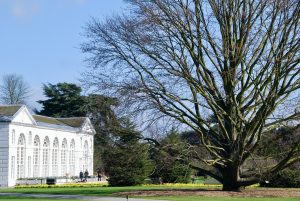The trees of Kew Gardens.

There are eleven thousand trees in Kew Gardens. Each year, a few trees are lost due to natural causes, old age, disease etc. In 2002, a drought resulted in the loss of some 400 trees. Such a prolonged dry spell is likely to occur again and again as global temperatures rise, and climate change takes a hold.
Modelling of future climate scenarios by Kew scientists suggests that towards the end of this century between a third and a half of Kew’s trees could be lost. Trees like the English oak, beech, birch and holly could be vulnerable to warmer temperatures and extended dry spells. There is a plan at Kew to replace gradually trees with species currently found in warmer areas, such the Mediterranean, Asia and Central America. Examples might include species such as the iberian alder, cherry hackberry and Montezuma’s pine. Many of the plants in the gardens will survive, [including Kew’s ‘Old Lions’] as they were collected from in and around the Mediterranean; some of these date back to the victorian era or earlier.
The ‘old lions’ of Kew are trees from the original grounds / garden that still survive. Examples include :
- Japanese pagoda tree (Styphnolobium japonica)
- Maidenhair tree (Ginkgo biloba)
- Oriental plane (Platanus orientalis)
- Caucasian elm (Zelkova carpinifolia)
- Black locust (Robinia pseudoacacia)

The Caucasian elm dates from 1762, when an arboretum was planted. It is thought that it might have been in a batch of plants from the Caucasus, planted in what is now the herbarium paddock. In 1905, the height of the tree was recorded as 60 feet (18M), though they can grow to 100 feet. A larger caucasian elm can be seen at Tortworth.
One species of oak that is common at Kew is the holly or holm oak (Quercus ilex). This is a common, naturalised oak that was probably introduced into the country in the sixteenth century. It is a hardy, slow growing tree and many new holm oaks were planted in 2008 to redefine the Syon Vista. The wood of the tree is strong and, in the past, it was used in carts and farming equipment. Its acorns start off green in colour but turn a reddish brown; they are a tasty treat for pigs.
The threat to Kew's trees is not unique, parks and urban spaces across the country need to plan for the future, to ensure that their trees can offer some resilience to changing weather patterns.
Full details of Kew's planning here.

Comments are closed for this post.
